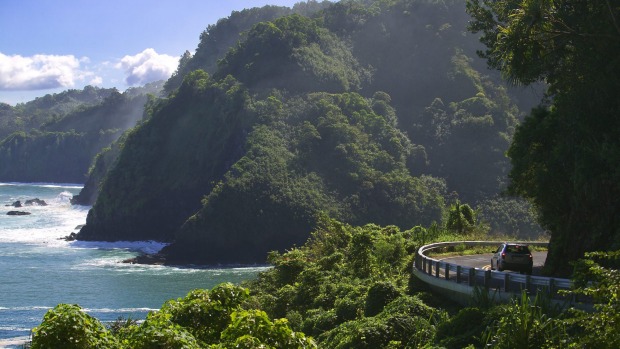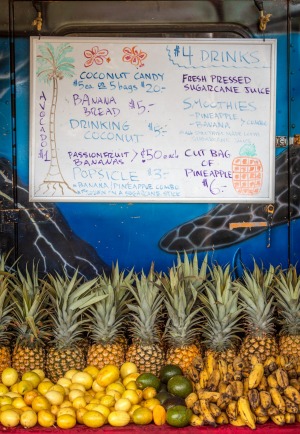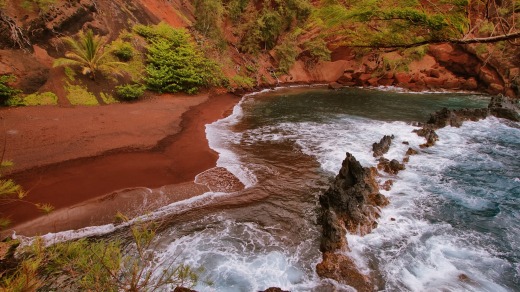
"If you don't choose beauty when it happens, you will miss out," cultural guide Mapuana Kalaniopio-Cook says, as she pauses to show us a small pond that has sprung up after the previous evening's thunderstorm. "You are witnessing creation right here."
We kneel at the edge of the shallow pool, its opalescent surface shimmering with light, larva and life. "In the blink of an eye, magic happens."
This is what I've come for, the promise of magic along the Hana Highway on Maui's rugged east coast. Also known as the "Road to Hana", sections of this serpentine road follow an ancient pathway known as the King's Highway, a meandering trail sculpted centuries ago by the marching feet of Hawaiian nobility. Unspooling for 100 kilometres between Kahului and Hana, this is one of America's great road trips.

While most visitors attempt some Daniel Ricciardo fantasy, racing around the 620 curves and 59 narrow bridges (and back) in one day, my husband and I decide to stretch the journey over three nights. By travelling slowly and deliberately, we plan to make time for the detours and distractions and to learn more about the real aloha – the spirit of loving kindness.
Kalaniopio-Cook begins her walking tour of Hana with a Hawaiian chant or "oli', first to introduce her family line, then to ask her ancestors for guidance and finally to give thanks for this wonderful morning. This is my third trip to Hawaii in as many years, but every time I hear the vocal display of love Hawaiian's have for their land I get goosebumps (or "chicken skin", as the locals say).
Our road trip began three days earlier in Paia, just east of Kahului, Maui's commercial centre and site of the main airport. Fringed by surf beaches and hemmed by sugar cane, bohemian Paia has long attracted drifters and dreamers. Home to everything from galleries and crystal shops to art exhibitions and film nights, we find that Paia is still firmly grounded in the Age of Aquarius, just with better restaurants.

While the stoners and surfers are still in town (initially drawn to Jaws, a legendary surf break), Paia also has a buzzing contemporary art scene and a string of fancy farm-to-table restaurants. After a night at the boutique retreat Lumeria Maui, we rise before dawn, trading our swimsuits for ski jackets and drive the twirling mountain road to the summit of Haleakala volcano (3055 metres), a dormant, shield volcano that forms more than 75 per cent of the island.
Standing above the clouds, the sun breaks the horizon, appearing first as a papaya-coloured blush then as a fireball throwing sunbeams across the lip of the crater. Looking across it is easy to see why the Hawaiians named the mountain House of the Sun. Afterwards, we hike to the crater floor, descending the Sliding Sands trail and watching in awe as twin rainbows shoot across the moonscape, drenching the scene in a palette of peach, purple and pewter. Surrounded by cinder cones and volcanic ash, I feel the magnetic energy of a landscape shaped over eons by the creative and destructive forces of nature.
On day two, we leave Paia, eschewing the multitude of audio CD guides on sale (cue American drawl, "pull over at the 12-mile marker …") for a music selection. We wind along the coast, clinging to a narrow strip of asphalt, the Pacific Ocean to our left and dripping rainforest to our right.

While moody music and outrageous scenery provide the first two road trip essentials, Twin Falls provides the third – car snacks. Dotted along the Hana Highway like a colourful daisy chain lies a fruity garland of farm stands, the moisture-laden slopes of east Maui delivering the perfect growing conditions for tropical fruits – "canoe crops" brought over by early Polynesian settlers.
Slurping pineapple juice and nibbling still-warm banana bread, we drive on, past waterfalls and over one-lane bridges, the road unfurling like a curling ribbon. We stop briefly at the Garden of Eden, where scenes from the opening sequence of Jurassic Park were shot, before turning off to Honomanu Bay. Though the Pacific is ever present, its convoluted coastline guards access like a possessive lover; beaches are hidden at the base of ferocious cliffs, pathways blocked by Triffid-like plants.
A side track brings us to the bay, where a black sand beach smoulders against jade-green vegetation. With the sun high in the sky, we sit and watch local surfers ride waves, overlooked by a gaggle of bikini-clad girls. A sudden sun shower, which we have now come to expect, sends us back to our car.
Further on we detour to the Ke'anae Peninsula, a landscape of taro fields and black beaches, where we stop to admire a stone church built in 1860 from lava rocks. Under a swaying palm tree I spot an elderly woman placing a frangipani lei at its base, and wonder about her story. After a brief introduction she tells me that a Hawaiian lei represents love and it is customary to return flowers to the earth. "Doing so is a sign of remembrance or respect," she says.
Our next distraction is the "Halfway to Hana" fruit stand (more two-thirds than halfway) for a quick sandwich, before stopping at the Upper Waikani (Three Bears) Falls. The day-trippers, in their flashy Mustang convertibles, have dropped away, and ours is the only car parked by the roadside. At first the track is hard to find but, after a few tentative steps, we are swallowed by the rainforest, a steep and muddy path leading us beneath the arches of a moss-covered bridge to a perfectly formed swimming grotto. Floating on my back with my face showered by the triple waterfall, I can feel a vortex of energy pushing me in circles. Perhaps it's the Hawaiian "mana" or life force I keep hearing about, or perhaps it's simply the energy created by the turbulent waterfalls, either way, it gives me chicken skin, and it's not from the cold.
Nahiku village provides another chicken-skin moment. After driving through a veil of evergreen, where tendrils and vines swing like Tarzan ropes at the road's edge, we reach a grassy knoll with views stretching back along the crenulated coast to Ke'anae. Below us black boulders glisten against a cobalt-blue sea while, overhead, green leaves tinged with scarlet flutter like butterflies.
After a peaceful hour, we push on, keen to make Hana before nightfall.
Our base in Hana is the sprawling, cliff-top resort Travaasa Hana, where, the following morning, we meet Kalaniopio-Cook. She tells us the legend of the demigod Maui, who turned his daughter Noenoe into a misty rain and her forbidden lover Ka'uiki into a hill, the very one we are standing on. Looking across the corrugated ocean, it's easy to sense that the gods are still in control on this remote corner of Maui.
gohawaii.com/au
Hawaiian Airlines flies daily from Sydney to Honolulu, Oahu, with connections to Maui. Melbourne passengers fly Virgin Australia to Sydney to connect. Australians must apply for US travel authorisation before departure. See hawaiianairlines.com.au; https://esta.cbp.dhs.gov/esta/.
Rooms at the wellness retreat Lumeria Maui, just outside Paia, cost from $US329. See lumeriamaui.com.
Travaasa Hana offers cultural, culinary and adventure experiences. Rooms from $US400. See travaasa.com.
Rental cars can be picked up at Kahului airport (Budget has an intermediate-sized vehicle from $US72/day). Note – check your rental car agreement if you wish to travel on portions of the unsealed roads beyond Hana. See budget.com.
The writer travelled as a guest of Hawaii Tourism Oceania.